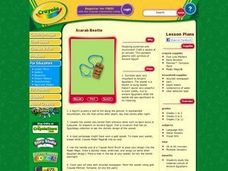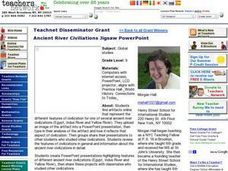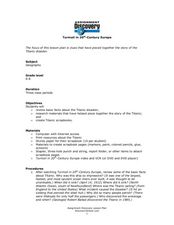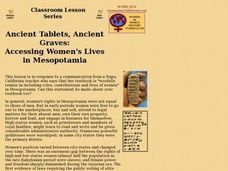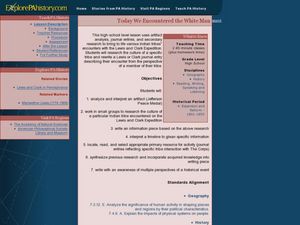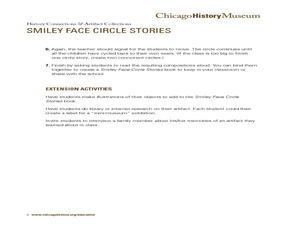Curated OER
Creating Historians Part Two: The Grab Bag
You don't need to be a museum curator to bring artifacts into the classroom; part two of a series on approaching social studies as a group of historians.
Curated OER
What Can We Learn From the Past?
What would future archeologists learn from your scholars' personal belongings? Have them bring in a box of "primary sources" from their home. Discuss the difference between observations and inference, using some of your own items to...
Curated OER
Art: African Collar Necklace
Students investigate the significance of African collar necklaces. To make replicas of the jewelry, they cut out the centers of paper plates leaving only the ribbed edges. To complete the necklaces, students apply tempera paints and...
Curated OER
Scarab Beetle
Students research the importance of symbols to the material culture of the Ancient Egyptians. They investigate the use and meaning of the scarab in Egyptian culture and recreate the Egyptian artifact using white Crayola Model Magic.
Curated OER
Wreck Detectives
Junior archaeologists examine types of artifacts from the Bronze Age on the internet. In collaborative groups, they create a story about a ship from this period and then construct a model of the ocean floor after their ship has sunk....
Curated OER
Ancient Babylon
Authenticate an ancient civilizations study by having historians analyze primary source artifacts. After examining an image of a Babylonian king votive statue, pupils read a short background context. They then answer 3 questions based on...
Curated OER
Ancient River Civilizations Jigsaw PowerPoint
Ninth graders use captions to determine an artifact's function and to list the features of a civilization. They classify artifacts according to the 8 Features of Civilization and for each Feature of Civilization they locate one artifact...
Curated OER
Marine Archaeology
Students examine marine archaeology. In this archaeological data lesson, students see how archaeologists use data to make inferences about shipwrecks. Students read data and make their own inferences, write about marine life and...
Curated OER
The Titanic Disaster
Seventh graders explore the titanic disaster. In this geography lesson, 7th graders research basic facts about the Titanic. Students create Titanic scrapbooks.
Curated OER
Archaeology and Storytelling
Students identify and interpret both individual families and whole cultures learn about their pasts by collecting and analyzing stories and artifacts. Then they identify that not all archaeological finds readily reveal their history to...
Curated OER
Basics of Archaeology
Students identify what and how to complete an Archaeological excavation is conducted. They identify the transition from one layer to the next more easily if the colors of the layers are different. When creating a dig, the teacher...
Curated OER
When Clay speaks
Learners listen as the teacher reads "When Clay Sings," by Byrd Taylor. They discuss clay, and view a variety of clay items. Students watch a video clip "Interests in One of a Kind Pots." They watch a demonstration on working with clay....
Curated OER
To Protect and Preserve
Students discuss the impact of war on the Iraqi National Museum and the importance of protecting artifacts of cultural heritage. They write letters to the Milwaukee Public Museum to show support for funding for the protection of the...
Curated OER
Archaeological Inquiry
Young scholars describe what they see as they observe an "artifact". They draw conclusions based on the information gathered to identify what the artifact might be used for and determine how old it might be.
Curated OER
Back From the Future
Students pose as archaeologists, famous for their scholarly excavations, writing, and lectures about ancient cultures and are invited back to the 20thy century from the year 3000 to explore an archaeological sit, their classroom.
Curated OER
In Celebration of the Silk Road
Sixth graders explore the ancient trade routes of the Silk Road with a focus on a province in China to identify artifacts and research how these items arrived in the city of Turpan.
Curated OER
Ancient Tablets, Ancient Graves: Accessing Women's Lives in Mesopotamia
Students explore the role of women in ancient Mesopotamia. Several excerpts from the Mesopotamian cuneiform tablets and artifacts are analyzed to determine the treatment, rights, and powers of women in this era.
Curated OER
Egypt's golden Empire
Students explore many of the key scientific and technological contributions made by the ancient Egyptians. Researched data is presented to the entire group.
Curated OER
Unearthing the Past
Learners analyze artifacts from an early society to determine information relating to daily life in that society. They consider which artifacts from our society would be most valuable to future archeologists.
Curated OER
The Iron Cheesebox
High schoolers describe the oxidation/reduction reactions that are involved in the corrosion of iron in seawater. In this marine sanctuary instructional activity students study the steps in conserving marine archaeological...
Curated OER
Stampin' Around Chicago
Students discuss the United States Postal Service and choose an artifact from one decade. In this art lesson, students research how the artifact chosen relates to Chicago and the United States. Students create their own postage stamp...
Curated OER
Today We Encountered the White Man
High schoolers analyze and interpret artifacts and a timeline to get specific information. In this timeline lesson plan students work in groups to research an Indian tribe and write an information piece of their research.
Curated OER
Shipwreck Mystery
Students study web pages on a shipwreck then locate where this took place on a map. In this marine archaeologist instructional activity students examine what clues archaeologists use to find the location of a shipwreck and ...
Curated OER
Smiley Face Circle Stories
Students examine different artifacts from the 1970's. In this history lesson plan, students discover what each artifact is by seeing the artifact and reading a card defining what the artifact represents. On the second day, students...





